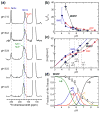Structural Basis for Asymmetric Conductance of the Influenza M2 Proton Channel Investigated by Solid-State NMR Spectroscopy
- PMID: 28535993
- PMCID: PMC5761075
- DOI: 10.1016/j.jmb.2017.05.015
Structural Basis for Asymmetric Conductance of the Influenza M2 Proton Channel Investigated by Solid-State NMR Spectroscopy
Abstract
The influenza M2 protein forms an acid-activated proton channel that is essential for virus replication. The transmembrane H37 selects for protons under low external pH while W41 ensures proton conduction only from the N terminus to the C terminus and prevents reverse current under low internal pH. Here, we address the molecular basis for this asymmetric conduction by investigating the structure and dynamics of a mutant channel, W41F, which permits reverse current under low internal pH. Solid-state NMR experiments show that W41F M2 retains the pH-dependent α-helical conformations and tetrameric structure of the wild-type (WT) channel but has significantly altered protonation and tautomeric equilibria at H37. At high pH, the H37 structure is shifted toward the π tautomer and less cationic tetrads, consistent with faster forward deprotonation to the C terminus. At low pH, the mutant channel contains more cationic tetrads than the WT channel, consistent with faster reverse protonation from the C terminus. 15N NMR spectra allow the extraction of four H37 pKas and show that the pKas are more clustered in the mutant channel compared to WT M2. Moreover, binding of the antiviral drug, amantadine, at the N-terminal pore at low pH did not convert all histidines to the neutral state, as seen in WT M2, but left half of all histidines cationic, unambiguously demonstrating C-terminal protonation of H37 in the mutant. These results indicate that asymmetric conduction in WT M2 is due to W41 inhibition of C-terminal acid activation by H37. When Trp is replaced by Phe, protons can be transferred to H37 bidirectionally with distinct rate constants.
Keywords: gating; ion channels; magic-angle-spinning NMR; proton dissociation equilibrium; tautomeric equilibrium.
Copyright © 2017 Elsevier Ltd. All rights reserved.
Figures









Similar articles
-
Elucidating Relayed Proton Transfer through a His-Trp-His Triad of a Transmembrane Proton Channel by Solid-State NMR.J Mol Biol. 2019 Jun 28;431(14):2554-2566. doi: 10.1016/j.jmb.2019.05.009. Epub 2019 May 11. J Mol Biol. 2019. PMID: 31082440 Free PMC article.
-
Solid-State NMR of Virus Membrane Proteins.Acc Chem Res. 2025 Mar 18;58(6):847-860. doi: 10.1021/acs.accounts.4c00800. Epub 2025 Feb 28. Acc Chem Res. 2025. PMID: 40019485 Free PMC article.
-
Structure and dynamics of the proton-selective histidine and the gating tryptophan in an inward rectifying hybrid influenza B and A virus M2 proton channel.Phys Chem Chem Phys. 2024 Jul 31;26(30):20629-20644. doi: 10.1039/d4cp01648c. Phys Chem Chem Phys. 2024. PMID: 39037444 Free PMC article.
-
Roles of the histidine and tryptophan side chains in the M2 proton channel from influenza A virus.FEBS Lett. 2003 Sep 18;552(1):35-8. doi: 10.1016/s0014-5793(03)00781-6. FEBS Lett. 2003. PMID: 12972149 Review.
-
Computational studies of proton transport through the M2 channel.FEBS Lett. 2003 Sep 18;552(1):23-7. doi: 10.1016/s0014-5793(03)00779-8. FEBS Lett. 2003. PMID: 12972147 Review.
Cited by
-
pH- and Calcium-Dependent Aromatic Network in the SARS-CoV-2 Envelope Protein.J Am Chem Soc. 2022 Apr 20;144(15):6839-6850. doi: 10.1021/jacs.2c00973. Epub 2022 Apr 5. J Am Chem Soc. 2022. PMID: 35380805 Free PMC article.
-
X-ray Crystal Structure of the Influenza A M2 Proton Channel S31N Mutant in Two Conformational States: An Open and Shut Case.J Am Chem Soc. 2019 Jul 24;141(29):11481-11488. doi: 10.1021/jacs.9b02196. Epub 2019 Jul 11. J Am Chem Soc. 2019. PMID: 31184871 Free PMC article.
-
Protonation equilibria and pore-opening structure of the dual-histidine influenza B virus M2 transmembrane proton channel from solid-state NMR.J Biol Chem. 2017 Oct 27;292(43):17876-17884. doi: 10.1074/jbc.M117.813998. Epub 2017 Sep 11. J Biol Chem. 2017. PMID: 28893910 Free PMC article.
-
High-Sensitivity Detection of Nanometer 1H-19F Distances for Protein Structure Determination by 1H-Detected Fast MAS NMR.J Phys Chem B. 2019 May 23;123(20):4387-4391. doi: 10.1021/acs.jpcb.9b03812. Epub 2019 May 8. J Phys Chem B. 2019. PMID: 31034230 Free PMC article.
-
M2 amphipathic helices facilitate pH-dependent conformational transition in influenza A virus.Proc Natl Acad Sci U S A. 2020 Feb 18;117(7):3583-3591. doi: 10.1073/pnas.1913385117. Epub 2020 Feb 3. Proc Natl Acad Sci U S A. 2020. PMID: 32015120 Free PMC article.
References
-
- Hille B. Ionic channels of excitable membranes. 2. Sundeland: Sinauer Associates Inc; 1992.
-
- Pinto LH, Lamb RA. The M2 proton channels of influenza A and B viruses. J Biol Chem. 2006;281:8997–9000. - PubMed
Publication types
MeSH terms
Substances
Grants and funding
LinkOut - more resources
Full Text Sources
Other Literature Sources
Research Materials
Miscellaneous

